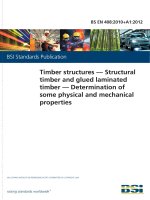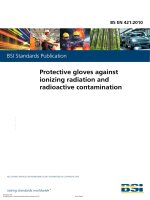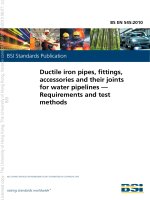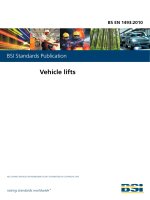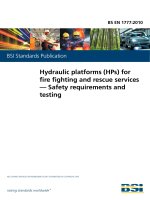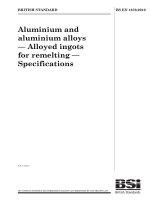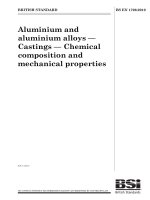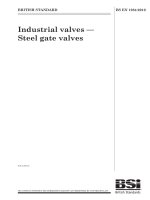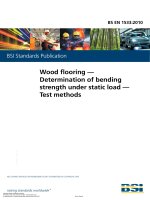Bsi bs en 61210 2010
Bạn đang xem bản rút gọn của tài liệu. Xem và tải ngay bản đầy đủ của tài liệu tại đây (1.71 MB, 38 trang )
BS EN 61210:2010
BSI Standards Publication
Connecting devices —
Flat quick-connect
terminations for electrical
copper conductors —
Safety requirements
BRITISH STANDARD
BS EN 61210:2010
National foreword
This British Standard is the UK implementation of EN 61210:2010. It is
derived from IEC 61210:2010. It supersedes BS EN 61210:1995, which will
be withdrawn on 1 November 2013.
The CENELEC common modifications have been implemented at the
appropriate places in the text and are indicated by tags (e.g. }~ ).
The UK participation in its preparation was entrusted by Technical Committee
PEL/23, Electrical accessories, to Subcommittee PEL/23/2, Connecting devices.
A list of organizations represented on this subcommittee can be obtained on
request to its secretary.
This publication does not purport to include all the necessary provisions of a
contract. Users are responsible for its correct application.
© BSI 2011
ISBN 978 0 580 61767 6
ICS 29.120.30
Compliance with a British Standard cannot confer immunity from
legal obligations.
This British Standard was published under the authority of the
Standards Policy and Strategy Committee on 28 February 2011.
Amendments/corrigenda issued since publication
Date
Text affected
EUROPEAN STANDARD
EN 61210
NORME EUROPÉENNE
EUROPÄISCHE NORM
November 2010
ICS 29.120.20
Supersedes EN 61210:1995
English version
Connecting devices Flat quick-connect terminations for electrical copper conductors Safety requirements
(IEC 61210:2010, modified)
Dispositifs de connexion Bornes plates à connexion rapide pour
conducteurs électriques en cuivre Exigences de sécurité
(CEI 61210:2010, modifiée)
Verbindungsmaterial Flachsteckverbindungen für elektrische
Kupferleiter Sicherheitsanforderungen
(IEC 61210:2010, modifiziert)
This European Standard was approved by CENELEC on 2010-11-01. CENELEC members are bound to comply
with the CEN/CENELEC Internal Regulations which stipulate the conditions for giving this European Standard
the status of a national standard without any alteration.
Up-to-date lists and bibliographical references concerning such national standards may be obtained on
application to the Central Secretariat or to any CENELEC member.
This European Standard exists in three official versions (English, French, German). A version in any other
language made by translation under the responsibility of a CENELEC member into its own language and notified
to the Central Secretariat has the same status as the official versions.
CENELEC members are the national electrotechnical committees of Austria, Belgium, Bulgaria, Croatia, Cyprus,
the Czech Republic, Denmark, Estonia, Finland, France, Germany, Greece, Hungary, Iceland, Ireland, Italy,
Latvia, Lithuania, Luxembourg, Malta, the Netherlands, Norway, Poland, Portugal, Romania, Slovakia, Slovenia,
Spain, Sweden, Switzerland and the United Kingdom.
CENELEC
European Committee for Electrotechnical Standardization
Comité Européen de Normalisation Electrotechnique
Europäisches Komitee für Elektrotechnische Normung
Management Centre: Avenue Marnix 17, B - 1000 Brussels
© 2010 CENELEC -
All rights of exploitation in any form and by any means reserved worldwide for CENELEC members.
Ref. No. EN 61210:2010 E
BS EN 61210:2010
EN 61210:2010 (E)
-2-
Foreword
The text of document 23F/200/FDIS, future edition 2 of IEC 61210, prepared by SC 23F, Connecting
devices, of IEC TC 23, Electrical accessories, was submitted to the IEC-CENELEC parallel vote.
A draft amendment was prepared by the Technical Committee CENELEC SR 23F, Connecting devices
and was submitted to formal vote.
The combined texts were approved by CENELEC as EN 61210 on 2010-11-01.
This European Standard supersedes EN 61210:1995.
Attention is drawn to the possibility that some of the elements of this document may be the subject of
patent rights. CEN and CENELEC shall not be held responsible for identifying any or all such patent
rights.
The following dates were fixed:
– latest date by which the EN has to be implemented
at national level by publication of an identical
national standard or by endorsement
(dop)
2011-11-01
– latest date by which the national standards conflicting
with the EN have to be withdrawn
(dow)
2013-11-01
This European Standard has been prepared under a mandate given to CENELEC by the European
Commission and the European Free Trade Association.
Annex ZA has been added by CENELEC.
__________
-3-
BS EN 61210:2010
EN 61210:2010 (E)
Endorsement notice
The text of the International Standard IEC 61210:2010 was approved by CENELEC as a European
Standard with agreed common modifications.
BS EN 61210:2010
EN 61210:2010 (E)
-4-
Annex ZA
(normative)
Normative references to international publications
with their corresponding European publications
The following referenced documents are indispensable for the application of this document. For dated
references, only the edition cited applies. For undated references, the latest edition of the referenced
document (including any amendments) applies.
NOTE When an international publication has been modified by common modifications, indicated by (mod), the relevant EN/HD
applies.
Publication
Year
Title
EN/HD
Year
1)
IEC 60068-1
1988
Environmental testing Part 1: General and guidance
EN 60068-1
1994
IEC 60352-2
2006
Solderless connections Part 2: Crimped connections - General
requirements, test methods and practical
guidance
EN 60352-2
2006
ISO 1456
2009
Metallic and other inorganic coatings Electrodeposited coatings of nickel, nickel
plus chromium, copper plus nickel and of
copper plus nickel plus chromium
EN ISO 1456
2009
ISO 2081
2008
Metallic and other inorganic coatings Electroplated coatings of zinc with
supplementary treatments on iron or steel
EN ISO 2081
2008
ISO 2093
1986
Electroplated coatings of tin - Specification
and test methods
-
-
1)
EN 60068-1 includes A1 to IEC 60068-1 + corr. October 1988.
–5–
BS EN 61210:2010
EN 61210:2010 (E)
CONTENTS
1
Scope ............................................................................................................................... 7
2
Normative references ....................................................................................................... 7
3
Terms and definitions ....................................................................................................... 8
4
Main characteristics.......................................................................................................... 8
5
Marking and information ................................................................................................... 9
6
Constructional requirements ............................................................................................. 9
7
General notes for tests ................................................................................................... 1 1
8
Type tests ...................................................................................................................... 1 2
8.1 Insertion and withdrawal force ............................................................................... 1 2
8.2 Mechanical overload force (for integral tabs or female connectors)........................ 1 2
8.3 Temperature rise ................................................................................................... 1 2
8.4 Current loading cyclic ............................................................................................ 1 3
8.5 Elevated temperature test ..................................................................................... 1 3
8.6 Tensile strength test for crimped connections ........................................................ 1 4
Annex A (informative) Maximum permissible temperature (maximum service
temperature) ......................................................................................................................... 2 4
Annex B (informative) Force gauge for testing flat quick-connect female connectors ............ 2 5
Annex C (informative) Female test connectors for testing with integral tabs ......................... 30
Annex E (informative) Information relating to cross section of conductors and
dimensions of male tabs ....................................................................................................... 33
Figure 1 – Dimensions of male tabs ...................................................................................... 1 9
Figure 2 – Dimensions of round dimple detents (see Figure 1) .............................................. 20
Figure 3 – Dimensions of rectangular dimple detents (see Figure 1) ..................................... 20
Figure 4 – Dimensions of hole detents (see Figure 1) ........................................................... 2 1
Figure 5 – Dimensions of female connectors ......................................................................... 2 1
Figure 6 – Double-ended tab................................................................................................. 2 2
Figure 7 – Location of thermocouples ................................................................................... 2 2
Figure 8 – Connections for electrical tests ............................................................................ 2 3
Figure B.1 – Force gauge fixture ........................................................................................... 2 5
Figure B.2 – Fixture adjustment ............................................................................................ 2 6
Figure B.3 – Fixture test tab centering .................................................................................. 2 7
Figure B.4 – In-line and lateral female connectors ................................................................ 2 8
Figure B.5 – Fixtureing alignment ......................................................................................... 2 9
Figure C.1 – Dimensions of female connectors ..................................................................... 30
Figure C.2 – Dimensions of female connectors, alternative design ........................................ 3 1
Table 1 – Dimensions of male tabs in millimetres .................................................................. 1 5
Table 2 – Dimensions of female connectors .......................................................................... 1 6
BS EN 61210:2010
EN 61210:2010 (E)
–6–
Table 3 – Test sequences and sets of samples ..................................................................... 1 6
Table 4 – Tolerances of test tab thickness ............................................................................ 1 6
Table 5 – Insertion and withdrawal forces ............................................................................. 1 7
Table 6 – Retention force...................................................................................................... 1 7
Table 7 – Test current for temperature rise ........................................................................... 1 7
Table 8 – Test current for current loading, cyclic ................................................................... 1 7
Table 9 – Pull force for testing the crimped connection ......................................................... 1 8
Table A.1 – Maximum permissible temperature (maximum service temperature) ................... 2 4
Table C.1 – Dimensions of female connectors in millimetres (see Figure C.1) ....................... 30
Table C.2 – Dimensions of female connectors in inches (see Figure C.1) ............................. 3 1
Table C.3 – Dimensions of alternative design female connectors in millimetres (see
Figure C.2) ........................................................................................................................... 3 1
Table C.4 – Dimensions of alternative design female connectors in inches (see Figure
C.2) ...................................................................................................................................... 3 2
Table E.1 – Relationships between conductors and tabs ....................................................... 3 3
–7–
BS EN 61210:2010
EN 61210:2010 (E)
CONNECTING DEVICES –
FLAT QUICK-CONNECT TERMINATIONS
FOR ELECTRICAL COPPER CONDUCTORS –
SAFETY REQUIREMENTS
1
Scope
This International Standard applies to non-insulated flat quick-connect terminations consisting
of a male tab of size 2,8 mm, 4,8 mm, 6,3 mm or 9,5 mm with hole or dimple detents and a
mating female connector for use as either an incorporated or an integrated part of an
equipment or of a component, or as a separate entity. This standard establishes uniform
requirements for the dimensions, performance characteristics and test program.
The connected electrical copper conductors shall be flexible or rigid stranded, having a crosssectional area up to and including 6 mm 2 or rigid solid having a cross-sectional area up to and
including 2,5 mm 2 . This standard shall not be used for connecting aluminum conductors.
The rated voltage shall not exceed 1 000 V a.c. with a frequency up to and including
1 000 Hz, and 1 500 V d.c., and having the temperature limits applicable to materials used
within this standard.
NOTE 1
This standard, where applicable, may be used for conductors made of material other than copper.
NOTE 2 For reasons of safety, it is recommended that flat quick-connect terminations beyond the scope of this
standard should not be interchangeable with those of this standard.
NOTE 3
This standard does not apply to female connectors with positive locking means.
NOTE 4 The flat quick-connect terminations covered by this standard are not intended to be disconnected by
pulling on the cable.
NOTE 5
2
Annex D provides additional information on non international units.
Normative references
The following referenced documents are indispensable for the application of this document.
For dated references, only the edition cited applies. For undated references, the latest edition
of the referenced document (including any amendments) applies.
IEC 60068-1:1988, Environmental testing − Part 1: General and guidance
IEC 60352-2:2006, Solderless connections − Part 2: Crimped connections – General
requirements, test methods and practical guidance
ISO 1456:2009, Metallic and other inorganic coatings − Electrodeposited coatings of nickel,
nickel plus chromium, copper plus nickel and of copper plus nickel plus chromium
ISO 2081:2008, Metallic and other inorganic coatings – Electroplated coatings of zinc with
supplementary treatments on iron or steel
ISO 2093:1986, Electroplated coatings of tin − Specification and test methods
BS EN 61210:2010
EN 61210:2010 (E)
3
–8–
Terms and definitions
For the purpose of this document the following terms and definitions apply:
3.1
flat quick-connect termination
electrical connection consisting of a male tab and a female connector which can be inserted
and withdrawn with or without the use of a tool
3.2
male tab
that portion of a flat quick-connect termination which receives the female connector
3.3
male test tab
male tab manufactured with tighter tolerances for the specific purpose of conducting
mechanical tests with production female connectors
3.4
female connector
that portion of a flat quick-connect termination which is pushed onto the male tab
3.5
detent
dimple (depression) or hole in the male tab which engages a raised portion on the female
connector to provide a latch for the mating parts
3.6
maximum permissible temperature
maximum service temperature
highest temperature which the flat quick-connect termination is allowed to attain in normal use
4
Main characteristics
4.1 Flat quick-connect terminations are classified into sizes according to the nominal width
and thickness of the male tabs. This standard covers the following nominal sizes:
–
2,8 mm × 0,5 mm
–
2,8 mm × 0,8 mm
–
4,8 mm × 0,5 mm
–
4,8 mm × 0,8 mm
–
6,3 mm × 0,8 mm
–
9,5 mm × 1,2 mm
NOTE
Relationship between millimetres and inches is shown in Table D.2.
4.2 The preferred conductor cross-sectional areas shall be 0,2 mm 2 , 0,34 mm 2 , 0,5 mm 2 ,
0,75 mm 2 , 1,0 mm 2 , 1,5 mm 2 , 2,5 mm 2 , 4,0 mm 2 and 6,0 mm 2 .
NOTE The approximate equivalent relationship between cross-sectional area in mm 2 and AWG sizes is shown in
Table D.3.
–9–
5
BS EN 61210:2010
EN 61210:2010 (E)
Marking and information
5.1 The manufacturer of male tabs and/or female connectors supplied separately and the
manufacturer of the component with integral tabs and/or female connectors shall provide
adequate information to ensure that the flat quick-connect termination can be applied in the
intended manner and that the testing authority can perform the relevant tests in accordance
with this standard.
5.2
This information shall be provided in the following methods, as detailed in 5.3:
–
by marking (Ma)
The information shall be clearly and indelibly marked on the male tab and on the
female connector.
NOTE In the case of integral tabs (e.g. in switches for appliances) the marking may be located on the
switch itself.
–
by documentation (Do)
The information shall be provided by a separate document, which may consist of a
leaflet, label or a specification sheet, supplied with the smallest package unit or
supplied separately. The content of the document shall be available to the end user or
to the component or equipment manufacturer and to the testing authority, as
appropriate, in any suitable format. The format in which this information is presented is
not within the scope of this standard.
–
by declaration (De)
This information shall be provided to the testing authority for the purpose of testing
and in a manner agreed between the testing authority and the manufacturer.
5.3
The following information shall be supplied by the methods indicated.
a) Manufacturer's name or trade mark ............................................ Ma (see note 1)
b) Type reference........................................................................... Do (see note 2)
c) Nominal series designation (size: width and thickness, see 4.1) .. Do (see note 2)
d) Maximum permissible temperature if higher than 85 °C ............... Do (see note 3)
e) The most onerous combination of the tab and the female connector ................Do
f)
Type of conductor(s) for which that part of the termination is suitable..............Do
g) Conductor cross-sectional area for which that part of the termination
is suitable ......................................................................................................Do
h) The recommended method of attaching the conductor to the termination
(i.e. tool, stripping length, any special preparation, etc.) .................................Do
i)
The material(s) and type of coating ................................................................De
NOTE 1 The information for integrated tabs or female connectors may be given together with the equipment or
component.
NOTE 2
An appropriate code may be used for this information.
NOTE 3 The insulation of the cable and of the contact-carrying plastic parts should be compatible with the
declared maximum permissible temperature.
NOTE 4
6
In Japan, tab thickness marking on the female connector is 5 for 0,5 mm and 8 for 0,8 mm.
Constructional requirements
6.1 Flat quick-connect terminations shall be so designed and constructed that in normal use
their performance is reliable and without danger to the user or surroundings.
BS EN 61210:2010
EN 61210:2010 (E)
– 10 –
Compliance is checked by the tests of 8.1 to 8.6.
6.2 Male tabs and female connectors shall be of a metal having mechanical strength,
electrical conductivity and resistance to corrosion adequate for their intended use.
Compliance is checked by inspection, by the tests of 8.1 to 8.6 and, if necessary, by chemical
analysis.
Examples of suitable metals, when used within the permissible temperature range and under
standard atmospheric conditions, are
–
copper (for tabs only);
–
an alloy containing at least 58 % copper for parts made from rolled sheet (in cold
condition) or at least 50 % copper for other parts;
–
stainless steel containing at least 13 % chromium and not more than 0,09 % carbon;
–
steel provided with an electroplated coating of zinc (for earthing conductors only),
according to ISO 2081;
–
steel provided with an electroplated coating of nickel, according to ISO 1456;
–
steel provided with an electroplated coating of tin, according to ISO 2093.
NOTE The choice of material and coating is left to the relevant product committees who should consider the
pollution conditions occurring in the equipment or component where the flat quick-connect termination is mounted.
6.3 The dimensions of male tabs shall comply with those specified in Table 1 and Figures 1,
2, 3 and 4 where the dimensions A, B, C, D, E, F, J, M, N and Q are mandatory.
NOTE 1 The shapes of the various parts may deviate from those given in the figures, provided that the specified
dimensions are not influenced and the test requirements are complied with, for example: corrugated tabs, folded
tabs, etc.
NOTE 2
Dimensions of male tabs in inches are shown in Table D.4.
Compliance is checked by inspection and measurement.
6.4 The dimensions of female connectors shall comply with those specified in Table 2 and
Figure 5 where L 2 , B 3 and 1,5 mm maximum are mandatory.
NOTE
Dimensions of female connectors for tab size in inches are shown in Table D.5.
Compliance is checked by inspection and measurement.
6.5 Male tabs and female connectors shall be so designed and constructed as to allow the
correct insertion and withdrawal of either the female connector or the tab without damage or
loosening of other components.
Compliance is checked by the insertion and withdrawal force test of 8.1.
6.6 Male tabs and female connectors integral with equipment or components shall be
securely retained.
Compliance is checked by the mechanical overload force test of 8.2.
6.7 Male tabs and female connectors shall be so designed and constructed that the
temperature rise in normal use does not reach values likely to impair their further use.
Compliance is checked by the temperature rise test of 8.3.
– 11 –
BS EN 61210:2010
EN 61210:2010 (E)
6.8 Male tabs and female connectors shall be so designed and constructed that their
electrical performances are reliable and their further use is not impaired.
Compliance is checked by the cyclic current loading test of 8.4.
6.9 Male tabs and female connectors having a maximum permissible temperature higher
than 85 °C shall be so designed and constructed that in normal use their electrical
performances are reliable and their further use is not impaired.
Compliance is checked by the elevated temperature test of 8.5.
Examples of maximum permissible temperatures of male tabs and female connectors,
depending on materials and/or coating, are given as a guide in Annex A.
6.10 Crimped connections shall be such that they withstand the mechanical stresses likely to
occur in normal use.
Compliance is checked by the tensile strength test of 8.6.
6.11 Male tabs and female connectors for solid conductors shall be so designed and
constructed that any disturbance does not affect the crimped connection and their further use
is not impaired.
Compliance is checked by the tests in 6.5 to 6.10.
7
7.1
General notes for tests
Tests according to this standard are type tests.
7.2 Unless otherwise specified, the samples shall be tested as delivered and connected as
for normal use, at an ambient temperature of 20 °C ± 5 °C.
7.3 Unless otherwise specified, all tests shall be carried out under standard atmospheric
conditions for testing as specified in IEC 60068-1.
7.4 Test specimens shall be preconditioned under standard atmospheric conditions for
testing for a time sufficient to allow the entire component to reach thermal stability.
7.5 Temperature rise and cyclic current loading tests shall be conducted in still air, i.e.
airflow less than 10 m/min at room temperature.
7.6 If samples are not delivered with conductors already assembled, the conductors shall be
connected to the associated parts in accordance with the manufacturer's instructions and
using the manufacturer’s recommended tooling. If no specific manufacturer’s instructions are
provided, then refer to IEC 60352-2 for proper assembly instructions.
7.7 The tests shall be carried out on each set in the sequence as specified in Table 3,
according to the most onerous combination of the tab and female connector according to item
e) of 5.3.
7.8 Testing for integral tabs (see item D of Table 3) shall be performed using the test
connectors in Annex C.
BS EN 61210:2010
EN 61210:2010 (E)
8
– 12 –
Type tests
8.1
Insertion and withdrawal force
Ten male test tabs and ten female connectors are required. The male tabs shall be special
male test tabs manufactured to close tolerances for the specific purpose of conducting this
test.
Male test tabs shall be of half-hard brass, having a hardness of (62 ± 7) HR30T and shall
conform to Figures 1, 2, 3 and 4 and Table 1, except that the C dimension tolerance shall be
as indicated in Table 4, and any raised plateau around the detent shall be limited to a total of
0,025 mm over the stock thickness (see Figure 1).
NOTE 1
Tolerances of nominal test tab thickness expressed in inches are shown in Table D.6.
The male test tabs shall not be coated.
NOTE 2
A male tab from the production line that complies with the dimensions for test tabs may also be suitable.
A new male test tab shall be used for each female connector tested. For each combination of
male tab and female connector, the tab shall be slowly and steadily inserted and withdrawn
six times at a rate of travel of approximately 1 mm/s.
Insertion and withdrawal force measurements shall be made with any suitable testing device
providing accurate alignment and being capable of holding the reading. An example of a
suitable device is shown in Annex B.
Compliance is checked as follows:
The insertion and withdrawal forces shall be within the limits as specified in Table 5.
NOTE 3
8.2
The insertion and withdrawal forces for sizes expressed in AWG are shown in Table D.7.
Mechanical overload force (for integral tabs or female connectors)
An axial force, equal to that shown in Table 6, is applied smoothly once only with a suitable
test apparatus for a period of 1 min. No damage which could impair further use shall occur to
the tab or to the female connector or to the equipment in which the tab is integrated.
NOTE
Retention force for sizes expressed in inches is shown in Table D.8.
Compliance is checked by inspection after completion of the test.
8.3
Temperature rise
The temperature rise test shall be conducted using six double ended male test tabs (see
Figure 6) and twelve female connectors connected to conductors of the same type and of the
largest cross-sectional area.
The test tab material shall be
–
uncoated half-hard brass having a hardness of (62 ± 7) HR30T for female connectors
made from copper alloy (coated or bare);
–
nickel coated steel for female connectors made of nickel coated steel or stainless steel.
The test shall be carried out with male tabs and female connectors as delivered. In no case
shall the test samples be cleaned or otherwise prepared prior to test, unless explicitly
required by the documentation.
– 13 –
BS EN 61210:2010
EN 61210:2010 (E)
Crimp terminations shall be crimped within 1 h after the removal of the insulation from the
associated conductors. The terminations shall be crimped with an appropriate crimping tool
which has been adjusted in accordance with the manufacturer's instructions.
All test samples are subjected to visual examination and dimensional measurement prior to
connecting the conductor.
Test samples shall be connected on each end of 178 mm length of uncoated insulated copper
conductors. The insulation of the conductor shall be as specified by the flat quick-connect
termination manufacturer.
The test samples shall be fitted with fine wire thermocouples placed in such a way so as not
to influence the contact or the connection area of the test sample. An example of placement is
shown in Figure 7. A thermocouple shall be installed so as to obtain thermal and mechanical
bonding with the surface of a connector and without causing an appreciable change in the
temperature of the connector, for example by the use of small quantities of an adhesive.
During the test, the samples shall be arranged and connected as shown in Figure 8. The test
current as specified in Table 7 is passed through the samples until thermal equilibrium has
been established. The temperature of the samples and the ambient temperature are
measured and recorded.
NOTE 1
With agreement between the testing facility and the manufacturer, the test current may be increased.
NOTE 2
Test current for temperature rise for sizes expressed in AWG is shown in Table D.9.
Compliance is checked as follows:
The temperature rise of any individual connection shall not exceed 30 K.
8.4
Current loading cyclic
The test shall be carried out on the samples already subjected to the temperature rise test of
8.3.
Cross-sectional areas, insulation of conductors and the test arrangement shall be as for 8.3.
The twelve samples are subjected to 500 cycles. Each cycle consists of 45 min under the
overload test current as specified in Table 8 and 15 min without current.
NOTE
Test current for current loading cyclic for sizes expressed in AWG is shown in Table D.10.
Compliance is checked as follows:
The temperature rise Δt 1 of any individual connection shall be measured after the 24th cycle
and the temperature rise Δt 2 of any individual connection shall be measured after the 500th
cycle. The Δt 2 value shall not exceed the Δt 1 value by more than 15 K. Neither individual
temperature rise, Δt 1 or Δt 2 , shall exceed 85 K.
8.5
Elevated temperature test
The test shall be performed in a heating cabinet at the declared maximum permissible
temperature, decreased by 45 K, on samples having a maximum permissible temperature
higher than 85 °C and already subjected to the tests of 8.3 and 8.4.
Cross-sectional areas, insulation of conductors and the test arrangement shall be as specified
in 8.3.
BS EN 61210:2010
EN 61210:2010 (E)
– 14 –
Care shall be taken not to disturb the samples, the conductors or the test arrangement when
placing them in the heating cabinet.
The samples are subjected to eight cycles of elevated temperature. Each cycle consists of 23
h applying the test current as specified in Table 7 and 1 h without current. After the first hour,
the temperature of the heating cabinet is adjusted, if necessary, until the average temperature
using all the samples under test equals the maximum permissible temperature.
After the last heating cycle, the samples are allowed to cool down to ambient temperature.
Compliance is checked as follows:
The temperature rise test of 8.3 shall be repeated using the current from Table 7, and the
temperature rise for any connector shall not exceed 45 K.
NOTE
8.6
Test current for temperature rise for sizes expressed in AWG is shown in Table D.9.
Tensile strength test for crimped connections
The test shall be conducted on 10 new samples, with any wire insulation support rendered
mechanically ineffective.
The conductor shall be assembled to the connector using the manufacturer's instructions and
with the specified crimping tool.
All declared cross-sectional areas of conductors shall be tested.
Additionally, when a combination of two or more conductors is declared, each conductor shall
be tested individually, in turn, and in accordance with the pull force value of its crosssectional area.
The pull force as specified in Table 9 shall be applied for 1 min without jerks, or applied with a
tensile machine with the head traveling at a speed of between 25 mm and 50 mm per min.
Compliance is checked as follows:
The force required to separate the crimping area from its attached conductor shall not be less
than the pull force of Table 9.
NOTE 1
Tensile strength values for other methods of connection of the conductor are under consideration.
NOTE 2 For conductor connection means other than crimping, a special test may be agreed upon between
manufacturers and testing stations.
NOTE 3
The pull force for sizes expressed in AWG is shown in Table D.11.
9,5 × 1,2
6,3 × 0,8
4,8 × 0,8
4,8 × 0,5
2,8 × 0,8
2,8 × 0,5
hole
hole
dimple
hole
dimple
hole
dimple
hole
dimple
hole
dimple
Nominal size
0,7
1,3
0,5
1,0
0,7
1,0
0,6
1,0
0,7
1,0
0,6
0,9
0,6
0,9
0,3
0,6
0,3
0,6
0,3
0,6
0,3
0,6
A
12,0
7,8
7,8
6,2
6,2
6,2
6,2
7,0
7,0
7,0
7,0
B
min.
1,17
1,23
0,77
0,84
0,77
0,84
0,77
0,84
0,77
0,84
0,47
0,54
0,47
0,54
0,77
0,84
0,77
0,84
0,47
0,54
0,47
0,54
C
9,40
9,60
6,20
6,40
6,20
6,40
4,67
4,90
4,60
4,80
4,67
4,90
4,60
4,80
2,70
2,90
2,70
2,90
2,70
2,90
2,70
2,90
D
4,5
5,5
4,3
4,7
3,6
4,1
3,0
3,4
2,3
2,8
3,0
3,4
2,3
2,8
1,3
1,8
1,3
1,8
1,3
1,8
1,3
1,8
E
(see 6.3)
1,7
2,0
1,6
2,0
1,6
2,0
1,3
1,5
1,3
1,5
1,3
1,5
1,3
1,5
1,1
1,3
1,1
1,3
1,1
1,3
1,1
1,3
F
6°
14°
8°
12°
8°
12°
8°
12°
8°
12°
8°
12°
8°
12°
8°
12°
8°
12°
8°
12°
8°
12°
J
Table 1 – Dimensions of male tabs in millimetres
2,2
2,5
1,4
1,7
1,4
1,7
1,4
1,7
1,4
1,7
M
1,8
2,0
1,2
1,5
1,2
1,5
1,0
1,4
1,0
1,4
N
1,0
2,0
0,7
1,8
0,7
1,8
0,7
1,8
0,7
1,8
0,6
1,7
0,6
1,7
0,3
1,4
0,3
1,4
0,3
1,4
0,3
1,4
P
13,1
8,9
8,9
7,3
7,3
7,3
7,3
8,1
8,1
8,1
8,1
Q
min.
Dimensions in millimetres
– 15 –
BS EN 61210:2010
EN 61210:2010 (E)
BS EN 61210:2010
EN 61210:2010 (E)
– 16 –
Table 2 – Dimensions of female connectors
(see 6.4)
Tab size
mm
mm
B 3 max.
L 2 max.
2,8 × 0,5
3,8
2,3
2,8 × 0,8
3,8
2,3
4,8 × 0,5
6,2
2,9
4,8 × 0,8
6,2
2,9
7,8
3,5
11,1
4,0
6,3 × 0,8
9,5 × 1,2
Table 3 – Test sequences and sets of samples
(see 7.7)
Sets
Number of new samples
per set
Tabs
A
B
6 doubleended tabs
10
(male test tabs)
C
(tabs)
Female
connectors
12
10
10
D
(integral tabs and
female connectors)
12
12
E
(integral female
connectors)
12
(male test tabs)
12
Clauses and
subclauses
6.3,
6.7,
6.8,
6.9,
6.4
8.3
8.4
8.5
Test sequence
Measurement of dimensions
Temperature rise test
Cyclic current loading
Elevated temperature test
6.3, 6.4
6.5, 8.1
6.10, 8.6
Measurement of dimensions
Insertion and withdrawal force
Tensile strength test for crimped
connections
6.3
6.10, 8.6
Measurement of dimensions
Tensile strength test for crimped
connections
6.3, 6.4
6.6, 8.2
Measurement of dimensions
Mechanical overload force
6.4
6.5, 8.1
6.6, 8.2
Measurement of dimensions
Insertion/withdrawal force
Mechanical overload force
Table 4 – Tolerances of test tab thickness
(see 8.1)
Nominal test
tab thickness
C Dimension
Maximum and minimum values of thickness
mm
mm
0,5
0,516
0,500
0,8
0,820
0,805
1,2
1,201
1,186
BS EN 61210:2010
EN 61210:2010 (E)
– 17 –
Table 5 – Insertion and withdrawal forces
(see 8.1)
Insertion force
N
Sixth withdrawal force
N
Maximum
Minimum
2,8 mm
53
5
4,8 mm
67
9
6,3 mm
80
18
9,5 mm
100
20
Size
mm
Table 6 – Retention force
(see 8.2)
Retention force
N
Size
NOTE
a
Push
Pull
2,8 mm
64
58
4,8 mm
80
98 a
6,3 mm
96
88
9,5 mm
120
110
The relevant product committee may consider increasing these values to allow a safety margin.
This is higher than that of the next larger size, due to existing designs.
Table 7 – Test current for temperature rise
(see 8.3 and 8.5)
mm 2
0,2
0,34
0,5
0,75
1
1,5
2,5
4
6
Test current
A
2
3
4
5,5
7,5
12
15
18
20
Table 8 – Test current for current loading, cyclic
(see 8.4)
mm 2
0,2
0,34
0,5
0,75
1
1,5
2,5
4
6
Test current
A
4
6
8
11
15
24
30
36
40
BS EN 61210:2010
EN 61210:2010 (E)
– 18 –
Table 9 – Pull force for testing the crimped connection
(see 8.6)
mm 2
0,2
0,34
0,5
0,75
1
1,5
2,5
4
6
Pull force
N
28
40
56
84
108
150
230
310
360
BS EN 61210:2010
EN 61210:2010 (E)
– 19 –
B
E
E
A
A
1,14 mm min.
L
D
45°(approx.)
D
45°(approx.)
Centre of detent
Q
Centre of detent
Optional shoulder
J
C
C
J
E
A
P
D
Alternative bevel
Centre of detent
Q
C
J
IEC 2043/10
NOTE 1 Bevel A × 45º need not be a straight line if it is within the confines shown, or it may be a segment of a
circle having a radius P and a segment altitude A.
NOTE 2 Dimension L is not specified and may vary by the application (e.g. fixing).
NOTE 3 Dimension C of tabs may be produced from more than one layer of material provided that the resulting
tab complies in all respects with the requirements of this standard. A radius on the longitudinal edge of the tab is
permissible.
NOTE 4
The sketches are not intended to govern the design except with regard to the dimensions shown.
NOTE 5
The thickness C of the male tab may vary beyond Q or beyond B + 1,14 mm.
NOTE 6 All portions of the tabs should be flat and free of burrs or raised plateau, except that there may be a
raised plateau over the stock thickness of 0,025 mm per side, in an area defined by a line surrounding the detent
and distant from it by 1,3 mm.
NOTE 7
For detent and hole dimensions ∅F, M and N, see Figures 2, 3 and 4.
Figure 1 – Dimensions of male tabs
(see 6.3 and 8.1)
BS EN 61210:2010
EN 61210:2010 (E)
– 20 –
0,076 mm min.
X
∅F
Radius
0,076 mm min.
X
Section X–X
IEC 2044/10
Detent shall be located within 0,076 mm of the centre-line of the tab.
Figure 2 – Dimensions of round dimple detents (see Figure 1)
(see 6.3 and 8.1)
0,076 mm min.
Y
M
Radius
Y
0,076 mm min.
N
Section Y–Y
IEC 2045/10
Detent shall be located within 0,13 mm of the centre-line of the tab.
Figure 3 – Dimensions of rectangular dimple detents (see Figure 1)
(see 6.3 and 8.1)
BS EN 61210:2010
EN 61210:2010 (E)
– 21 –
Z
∅F
Z
Section Z–Z
IEC 2046/10
Detent shall be located within 0,076 mm of the centre-line of the tab.
Figure 4 – Dimensions of hole detents (see Figure 1)
(see 6.3 and 8.1)
1,5 mm max.
B3
X
Outline of the female connector
B3
L2
IEC 2047/10
B 3 and L 2 mandatory
NOTE 1 For determining female connector dimensions varying from B 3 and L 2 , it is necessary to refer to the tab
dimensions in order to ensure that, in the most onerous conditions, engagement (and detent if fitted) between the
tab and female connector is correct.
NOTE 2 If a detent is provided, the dimension X is at the manufacturer's discretion provided it meets the
requirements of the performance clauses.
NOTE 3 Female connectors should be so designed that undue insertion of the conductor into the crimping area
is visible or prevented by a stop in order to avoid any interference between the conductor and a fully inserted tab.
NOTE 4
The sketches are not intended to govern the design except with regard to the dimensions shown.
Figure 5 – Dimensions of female connectors
(see 6.4)
BS EN 61210:2010
EN 61210:2010 (E)
– 22 –
10 mm
10 mm
See Figure 1
IEC 2048/10
Figure 6 – Double-ended tab
(see 8.3)
Thermocouple placement area
10 mm
Double-end tab
per Figure 6
10 mm
IEC 2049/10
Figure 7 – Location of thermocouples
(see 8.3)
BS EN 61210:2010
EN 61210:2010 (E)
– 23 –
Example of a test disposition
178 mm approx.
Power connector
Power connector
1 2
3 4
5 6
7 8
9 10
11 12
19 mm
Double-end tab
Steel screw and sleeve
19 mm
Phenolic laminate
Counter bore
Figure 8 – Connections for electrical tests
(see 8.3)
IEC 2050/10
